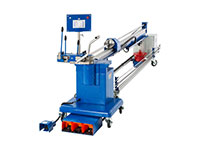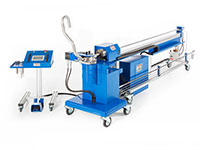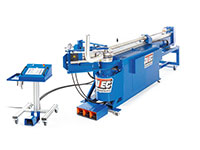Rotary draw bending with mandrel
In mandrel bending the tube is fixed between the bending tool and a clamp die. By rotation of the tool round the bending axis the tube is inclined in the radius of the bending tool. A counter bearing (counter rollers or sliding rail) supports the straight tube end from outside. A stationary inner mandrel caters for stabilisation from inside during bending and prevents formation of wrinkles and oval distortion. Depending on the individual application the mandrel is equipped with one or more balls fulfilling their function in the radius where they maintain the roundness of the material. If the material is too hard or if extremely thin-walled material is bent it is mandatory to use a wiper die. This tool prevents wrinkle formation in the inner radius in front of the tool. This procedure is applied for bending radii ≤ 2xD.
Clear advantages of these mandrel bending systems are:
- precise and extremely accurate on the bending axis ± 0.1°
- standard radii: Rm=2xD (Rm=1,5xD possible)
- during bending, the material keeps clamped on a carriage, equipped with digital evaluation of the position in length and torsional twisting. Thus a true-to-size realisation of the geometry is possible.
- depending on the respective machine control, automatic overbending of the tube is possible by means of a material database
- depending on the respective machine control, data can be imported from external calculation systems (e.g. CAD) via USB or LAN interface
- depending on the respective machine control, an “onboard calculation” of the tube geometry is possible, thus allowing free-hand drawing as well as reading in of Cartesian coordinates with subsequent conversion to bending data
- for bending without mandrel, the mandrel can be removed
- allows high-quality and narrow bends







